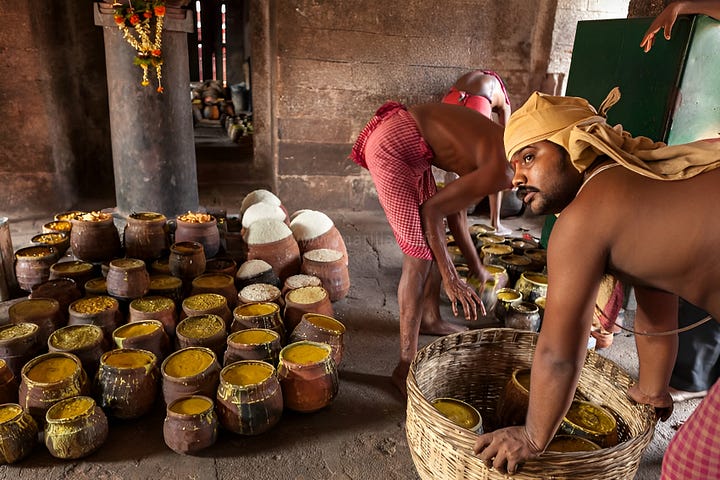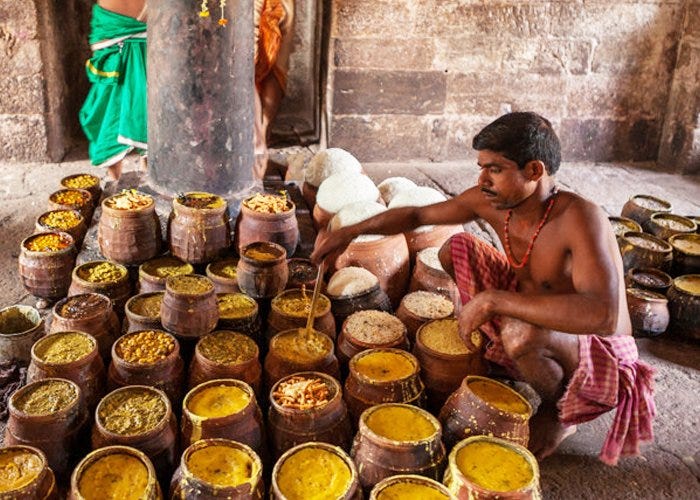The World’s Largest Spiritual Kitchen – The Sacred Mahaprasad Kitchen of Jagannath Temple, Puri
In the holy city of Puri, Odisha, lies one of the most extraordinary sacred spaces in the world—not a shrine, not a sanctum, but a kitchen.
This is Ananda Bazaar, the divine kitchen of Jagannath Temple, revered as the largest functioning kitchen in the world, and perhaps the only one where divine energy is believed to cook the food, not just fire or heat. This kitchen doesn’t simply prepare food—it crafts Mahaprasad, a sacred culinary offering where each grain is infused with devotion, ritual, and sanctity.
Let’s embark on a journey into this sacred culinary complex where bhakti (devotion), tantra (ritual science), and vastu (sacred architecture) blend seamlessly with logistics, discipline, and ancient wisdom.
🌍 Why It’s Called the World’s Largest Kitchen
The Jagannath Temple kitchen spans approximately 44,000 square feet, located in the southeastern part of the temple complex. Operated every single day of the year, it serves more than 20,000 devotees on a regular day, and on festivals, that number can exceed 50,000.
The kitchen is equipped with:
752 wood-fired stoves (known as "chulhas")
Each stove has 6 burners
9 clay pots (matkas) are stacked in pyramid style per burner
Over 56 dishes prepared daily, served six times a day
Only earthen pots are used; they are discarded after single use
This kitchen runs with such precise harmony and traditional rigor that it has functioned for centuries without a written operations manual.
🔱 A Divine Belief: Where God Eats
There is a sacred saying in Sanatan Dharma:
"Lord Rama bathes in Rameswaram, meditates in Badrinath, eats in Puri, and rests in Dwarka."
It is believed that Lord Jagannath himself partakes in the food here. Hence, food is not merely sustenance—it is Brahma, the divine. Mahaprasad is therefore revered not just as food, but as sacred energy that brings merit to the soul.


🛕 The Structure and Layout of the Kitchen
Upon entering the temple through the Simhadwar (main gate), one finds the kitchen complex to the left. Inside, a vast courtyard buzzes with activity—yet operates with astonishing discipline.
Key architectural and ritual features:
Located in the Agneya Kona (southeast corner) as per Vastu Shastra
Contains 9 sacred wells, especially the Ganga Kua (square) and Yamuna Kua (circular), used for cooking water
Tandoor-style stoves (chulhas) made from brick and clay
Food is cooked using only firewood sourced with ritual purity
Each stove acts as a sacred yantra. Before cooking begins, Vedic fire rituals (Agni Sanskar) are performed to invoke divine energies.
🪔 The Cooking Process – Sacred and Scientific
The cooking process is awe-inspiring and esoteric:
Clay pots filled with rice, dal, vegetables, and sweets are stacked vertically, one over another—up to five to seven levels high
Miraculously, the food in the topmost pot cooks first, followed by the ones below, despite the fire being at the bottom
This defies physics, but is accepted as a divine intervention by Lord Jagannath himself
This phenomenon is widely believed to be possible because Goddess Lakshmi herself prepares the food spiritually, and the fire acts merely as a conduit of her energy.
🧑🍳 The Human Machinery Behind the Divine Process
This operation is managed by a vast and highly specialized human workforce divided into ancient guilds:
Suaras – The main cooks (around 500), drawn from hereditary lines
Joganias – Assistants handling water, firewood, cleanliness (about 300)
Tunia – Helpers who provide support from outside the kitchen
Mahasuaras – Those who transport and distribute Mahaprasad
Kumbharas – Over 300 potters who make new clay pots daily
Training in these roles begins at the age of 12, ensuring a lifelong understanding of ritual purity, precision, and spiritual intent.
🥘 Mahaprasad – The Sacred Food Offerings
Mahaprasad is classified into three major categories:
Sankhudi (Cooked items) – Includes rice, dal, curries, khichdi, and vegetables
Nisankhudi (Dry items) – Includes laddus, khaja, gaja, malpua, and manohara
Nirmalya – Dried and consecrated rice used in rituals and healing
🍛 The 56 Bhog (Chhappan Bhog)
The temple prepares a divine menu of 56 items, traditionally offered to Lord Jagannath every day. The distribution includes:
9 varieties of rice: plain, lemon, ghee rice, curd rice, sweet rice, etc.
14 types of seasonal vegetables
9 milk-based items
11 sweetmeats
13 types of cakes, pancakes, and pithas
No garlic, onion, potato, or tomato is ever used. Instead, preferred ingredients include green banana, ridge gourd, pumpkin, and bottle gourd. The only fat used is pure desi ghee.
Spices are kept minimal—ginger, cumin, pepper, turmeric, cardamom, and cinnamon.
🕒 6 Daily Offerings (Bhog Niti)
Mahaprasad is offered to Lord Jagannath six times daily, each with distinct menu items and spiritual significance:
Gopal Vallabh Bhog (8:00 AM) – Fruits, curd, and butter
Sakala Bhog (10:00 AM) – Boiled black gram and other offerings
Madhyanha Bhog (12:00 PM) – Grand noon meal for the Lord
Sandhya Dhupa (2:00 PM) – Evening meal
Sayana Dhupa (7:00 PM) – Dinner before sleep
Bada Singhara Bhog (10:00 PM) – Night offering with sweets and milk
🔯 Sacred Rituals – From Grain to Mahaprasad
Mahaprasad follows 11 sacred transformations, from simple grain to divine offering:
Rice → Amuniya
Cooking → Anna
Transport to inner sanctum → Cheka
Offering on Shree Yantra → Bhoga
Infusion with Mantras → Naivedya
Serving to deities → Prasada
Offering to Goddess Vimala → Mahaprasad
Sanctified by Five Devas' Glance → Kaivalya
Devotees eat together → Aavadha
Dried rice → Nirmalya
Consumed post-puja → Parambrahma
🛕 Rath Yatra & Gundicha Temple Kitchen
During the Rath Yatra festival, Lord Jagannath travels to the Gundicha Temple, where Mahaprasad is prepared in a completely open-air kitchen, known as Agnya. Not even birds or animals are allowed to interfere during the sacred preparation.
🧂 A Living Miracle in Modern Times
Despite handling tens of thousands of devotees daily, no food is ever wasted, and no one goes unfed. What’s even more astounding is that the amount of food cooked each day varies precisely with the number of devotees—without the use of any modern forecasting tools. This precision is considered divine intervention.
More Than Food, It Is A Pilgrimage
The Mahaprasad kitchen of Jagannath Temple is not just the largest kitchen in the world—it is a living example of India’s spiritual engineering, cultural continuity, and divine logistics. Here, every grain is sacred, every pot a ritual, every fire a yagna.
For devotees, consuming Mahaprasad is equivalent to a spiritual initiation. It is not merely food—it is the divine Brahma, offered with devotion, transformed through ritual, and blessed by the gods.
So, the next time you step into Puri, don’t just seek darshan. Experience Mahaprasad—it is truly a holy pilgrimage in itself.


